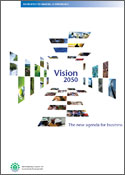Vision 2050 Lays a Pathway to Sustainable Living Within Planet
 New Delhi - The World Business Council for Sustainable Development (WBCSD) today launched the Vision 2050 report, a study that lays out a pathway leading to a global population of some 9 billion people living well, within the resource limits of the planet by 2050. The report, released at the World CEO Forum in New Delhi, India, was compiled by 29 leading global companies representing 14 industries.
New Delhi - The World Business Council for Sustainable Development (WBCSD) today launched the Vision 2050 report, a study that lays out a pathway leading to a global population of some 9 billion people living well, within the resource limits of the planet by 2050. The report, released at the World CEO Forum in New Delhi, India, was compiled by 29 leading global companies representing 14 industries.This work results from an 18-month combined effort with CEOs and experts, and dialogues with over 200 companies and external stakeholders in some 20 countries.
The report presents new opportunities for business in a broad range of business segments with the foresight to lead their societies on a sustainable business development agenda. Entitled Vision 2050: The new agenda for business, the report “lays out the challenges, pathway and options that business can use to create an opportunity-rich strategy, both regionally and globally, that will lead to a sustainable world,” said Dr. Mohammad A. Zaidi, Executive Vice President and Chief Technology Officer of Alcoa, who led the project as one of four co-chairs.
“The world already has the knowledge, science, technologies, skills and financial resources needed to achieve Vision 2050. However, concerted global action in the next decade will be required to bring these capabilities and resources together, putting the world on the path to sustainability,” explained WBCSD President Bjorn Stigson.
The publication outlines a future in which 9 billion people live well, enjoying health, food, shelter, energy, mobility, education and other basics of life. Syngenta CEO, Michael Mack added that “humanity has largely had an exploitative relationship with our planet; we can, and should, aim to make this a symbiotic one.” In the Vision 2050 scenario, global society attains this standard of living at a sustainable rate, without further harm to biodiversity, climate and ecosystem services.
The report states that the world already has the resources to achieve Vision 2050, but there is a catch: “The radical changes highlighted in Vision 2050 demand a different perspective from business leaders, requiring them to rethink how they operate to stay on-track for a sustainable future,” added Samuel A. DiPiazza Jr., former CEO and Chairman of PricewaterhouseCoopers. This includes a radical transformation of global markets, governance and infrastructure, and a re-thinking of our ideas of growth and progress.
Vision 2050 spells out the “must haves” – the things that must happen over the coming decade to make a sustainable planetary society possible. These include incorporating the costs of externalities, starting with carbon, ecosystem services and water, into the structure of the marketplace; doubling agricultural output without increasing the amount of land or water used; halting deforestation and increasing yields from planted forests: halving carbon emissions worldwide (based on 2005 levels) by 2050 through a shift to low-carbon energy systems and improved demand-side energy efficiency, and providing universal access to low-carbon mobility.
As part of this transformation, Vision 2050 calls for a new agenda for business: to work with government and society worldwide to transform markets and competition. “Sustainability will become a key driver for all our investment decisions,” added Idar Kreutzer, CEO of Storebrand and another project co-chair. New rules for markets will reframe environmental challenges as economic challenges, driving innovation and competition in the direction of sustainability and away from resource- and energy-intensive production. Rationalizing prices to include such externalities as climate and biodiversity impacts will make corporate environmental efficiency a true competitive advantage across all industries and regions.
Business will lead market change by doing what business does best: forming partnerships, creating efficiencies and competitive advantage, seizing opportunities and meeting customer needs. At the same time, a shift toward sustainability will trigger trillions of dollars in new investments in infrastructure, technology and human services, creating new opportunities for business to thrive and grow. A recent study commissioned for this project with PricewaterhouseCoopers and released today indicates that this investment could reach US$ 3-10 trillion per annum in 2050.
Vision 2050, with its best-case scenario for sustainability and pathways for reaching it, is a tool for thought leadership, a platform for beginning the dialogue that must take place to navigate the challenging years to come. “It is hoped that the Vision 2050 work will be used for many years to come. It is designed to be a platform for companies when deliberating strategies and for dialogue with governments and society about how to realize the sustainable future,” concluded Per Sandberg, Project Director for Vision 2050.
Download
- Vision 2050: The new agenda for business - full report
- Vision 2050: The new agenda for business - summary report
You can return to the main Market News page, or press the Back button on your browser.

